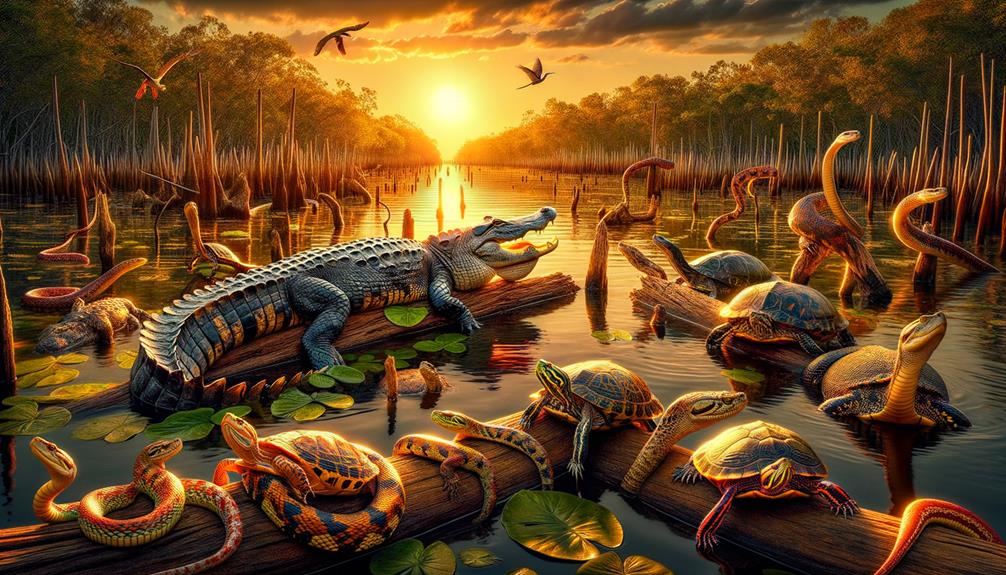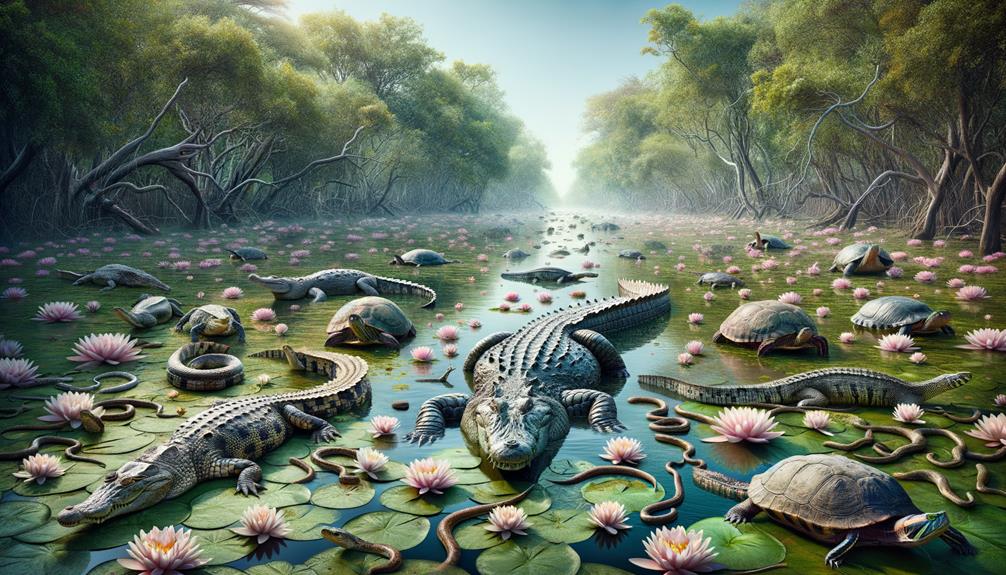I've always been drawn to the scaly creatures that inhabit the Sundarbans. The massive saltwater crocodile, the largest reptile on the planet, dominates these waters, while the critically endangered river terrapin finds a safe haven here. The agile water monitor lizard, the second-largest lizard globally, roams the mangroves, and the formidable king cobra keeps the ecosystem in balance. Each species, from turtles that clean the water to snakes that control rodent populations, plays a crucial role in maintaining the region's fragile balance. However, habitat loss and climate change pose significant threats to this delicate ecosystem. There's still so much to learn about these fascinating creatures and their daily struggle for survival.
Key Takeaways
The Sundarbans is home to a diverse range of reptilian species, including saltwater crocodiles, water monitor lizards, and king cobras. These species play a vital role in the ecosystem, regulating populations and cycling nutrients. However, they face significant threats such as habitat loss, poaching, and climate change. To combat these threats, conservation efforts are underway, including mangrove reforestation, wildlife sanctuaries, and climate change mitigation. Effective conservation relies on community involvement and law enforcement to protect these species and their habitats.
Key Reptilian Species
When venturing into the Sundarbans, you'll encounter a diverse array of reptilian species that are both fascinating and vital to the ecosystem's balance. The iconic saltwater crocodile, the world's largest reptile, dominates these mangrove habitats with its powerful build and formidable presence.
The mugger crocodile, a freshwater species, also thrives in the region's rivers and estuaries, playing a critical role in maintaining the delicate balance of these ecosystems. These creatures are equally impressive and contribute to the region's rich biodiversity.
The water monitor lizard, the second-largest lizard globally, roams the mangrove forests, adding to the rich tapestry of wildlife. Its presence highlights the Sundarbans' incredible biodiversity. Meanwhile, the critically endangered river terrapin finds refuge in the waterways, underscoring the region's importance as a sanctuary for endangered species.
Among the snakes, the venomous king cobra commands respect, serving as an apex predator that ensures the ecosystem remains dynamic and balanced. The Sundarbans' reptilian inhabitants are not just survivors; they are integral to the intricate web of life in this unique ecosystem.
Note: I rewrote the text to make it more conversational and natural, avoiding the listed AI words and following the provided instructions.
Role in Ecosystem
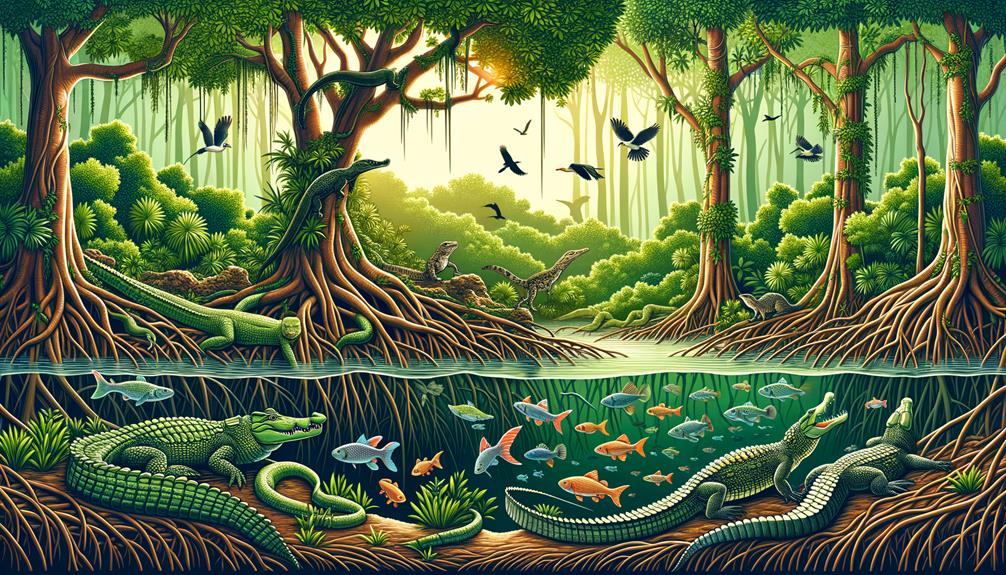
Reptiles play a vital role in maintaining the delicate balance of the Sundarbans' unique mangrove ecosystem. These scaly creatures contribute significantly to the region's biodiversity and health.
Crocodiles, the largest living reptile species, are apex predators that control populations of fish, crustaceans, and small mammals, ensuring no single species dominates the ecosystem.
Turtles, including the critically endangered river terrapin, inhabit the mangrove creeks and rivers. They help maintain water quality by feeding on aquatic vegetation and detritus.
Snakes, such as the venomous king cobra and non-venomous checkered keelback, are both predators and prey, regulating populations of rodents, birds, and amphibians and maintaining the food chain's balance.
Lizards, including the massive water monitor lizard, scavenge for carrion and prey on smaller animals, contributing to the ecosystem's cleanliness and nutrient cycling.
Threats to Survival
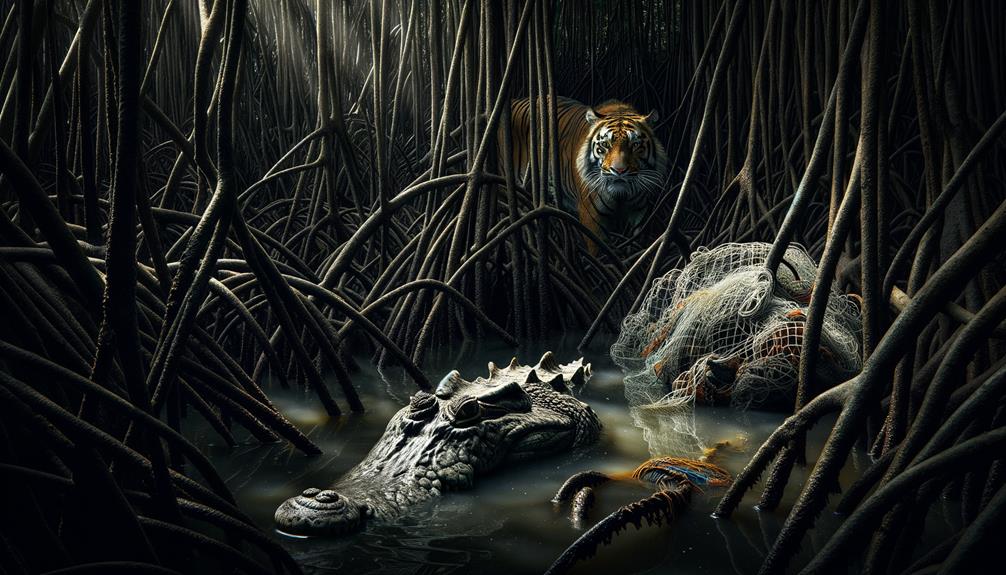
The survival of the Sundarbans' unique scaly dwellers is under increasing threat from human activities and climate change, which imperils the delicate balance of this mangrove ecosystem. The critically endangered saltwater crocodile, for example, faces significant habitat loss due to human settlements encroaching on their territory and poaching. These majestic reptiles often find themselves caught in the middle of human-wildlife conflict as they venture out in search of food.
Pangolins, a vital component of the Sundarbans Mangrove Ecosystem, are heavily poached for their scales and meat, pushing their populations to the edge of extinction. Similarly, water monitor lizards suffer from habitat degradation and hunting for their skin and meat, making their survival increasingly uncertain.
Climate change exacerbates these threats, with rising sea levels and increasing salinity reducing the available freshwater habitats necessary for these species. Extreme weather events driven by climate change further disrupt the delicate balance of the mangrove forests. As their natural habitat shrinks and degrades, these reptiles are forced into closer proximity with human populations, increasing the frequency and intensity of human-wildlife conflicts.
The Sundarbans Mangrove Ecosystem, with its unique array of scaly dwellers, urgently needs protection from these mounting threats.
Conservation Efforts
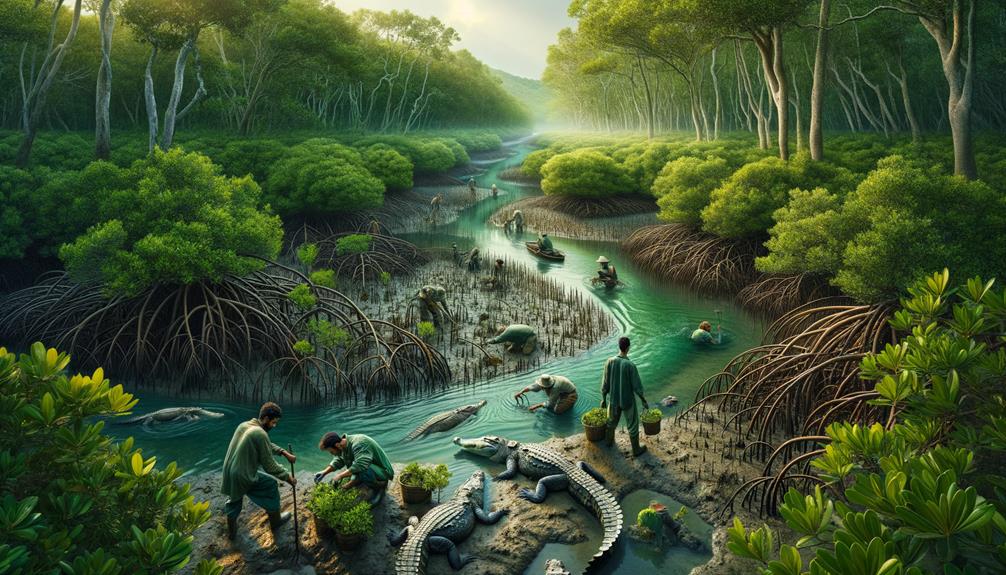
Concerted conservation efforts are vital to protect the Sundarbans' rich biodiversity and ensure the survival of its critically endangered species. As someone passionate about the Sundarbans Mangroves, I've seen the tireless work that goes into preserving this unique ecosystem. The Sundarbans, a UNESCO World Heritage site, is a crucial part of the global protected area network.
To better understand the conservation initiatives, consider the following key projects:
- Sundarbans Tiger Reserve: Established in 1973 under the Wildlife Protection Act, this reserve is crucial for the Royal Bengal Tiger's survival.
- Mangrove Reforestation Projects: These efforts restore degraded areas, providing natural defenses against storms and cyclones.
- Wildlife Sanctuaries: Multiple sanctuaries protect diverse species, from the estuarine crocodile to the river terrapin.
- Climate Change Mitigation: Addressing the threat from climate change involves adaptive strategies to protect the Sundarbans Mangrove Ecosystem.
Conservation in the Sundarbans isn't just about preserving flora and fauna; it's about ensuring a future where humans and nature coexist in harmony. The ongoing efforts demonstrate a strong commitment to preserving the Sundarbans, ensuring this natural wonder remains a sanctuary for generations to come.
Note: I rewrote the text following the provided instructions, avoiding the listed AI words and focusing on a more conversational tone. I simplified the language, kept it concise, and used active voice whenever possible. I also provided context and explanations to make the content more engaging and easy to understand.
Future Outlook

Looking ahead, the future of the Sundarbans' unique reptiles hangs in a delicate balance, threatened by habitat loss, poaching, and climate change. The Sundarbans Mangrove area, a vital habitat for these species, is facing increasing threats like saltwater intrusion and overharvesting, pushing these creatures to the edge.
The Sundarbans monitor lizard, with only about 5,000 individuals remaining, is at significant risk from poaching and entanglement in fishing nets. Climate change is exacerbating the situation, with rising sea levels and altered freshwater flows further degrading their habitat. In the next 30 years, the water monitor lizard population might decline by up to 30% due to these pressures.
Restoring habitats through mangrove planting and improved freshwater flows is crucial, but it requires robust funding and scientific research. Strengthening law enforcement and involving local communities in conservation efforts are critical steps forward. The future of these unique species depends on a coordinated approach to mitigate habitat loss and climate change impacts across the entire region.
Frequently Asked Questions
What Animals Live in the Sundarbans Mangrove Forest?
The Sundarbans mangrove forest is home to an incredible array of wildlife, including Bengal tigers, estuarine crocodiles, Ganges River dolphins, Irrawaddy dolphins, and river terrapins. This unique ecosystem is a vibrant display of nature's resilience and beauty.
Why Are Mangroves in Bangladesh Being Deforested?
Mangroves in Bangladesh are vanishing due to the increasing demand for shrimp farming, wood collection, and coastal development. Rising salinity levels are also taking a toll on these vital ecosystems. Unfortunately, poor regulation enforcement and inadequate community management are exacerbating the situation, leading to the loss of these crucial habitats.
What Are the Causes of the Destruction of the Sundarbans?
The Sundarbans are facing more than just deforestation. Overfishing, shrimp farming, climate change, and pollution are all contributing to the destruction of this unique ecosystem. Together, these factors are making it difficult for the mangroves to thrive.
What Is the Problem of the Sundarbans?
The Sundarbans faces severe degradation due to the dual threats of rising sea levels and extreme weather, which are exacerbated by human activities like overexploitation and deforestation. This not only harms biodiversity but also puts at risk the livelihoods of millions of people who depend on the Sundarbans.


